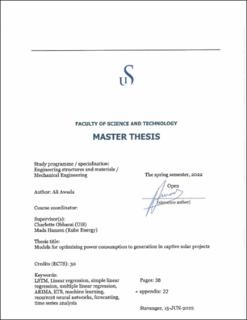| dc.description.abstract | Kube Energy is a renewable energy services company that has most of its solar power plants planned around a single or multiple off-takers (end-users) connected in a small mini-grid. What is common for these off-takers is that a large proportion of their power consumption is to cover air conditioning and water heating for offices and residences. To date, Kube has designed their systems with larger battery banks or spinning capacity in diesel generators to provide stability in the grid during the day, as well as to provide electricity during the night.
This year, Kube Energy has started a project with an aim at optimizing consumption of electricity to better match generation. This mainly entails scheduling loads for when there is high production from the PV (e.g., reheating water in hot water tanks or charging electrical vehicles) or cutting loads if there is an unscheduled decrease in generation (clouds). In this effort, Kube Energy is looking at methods for forecasting consumption and generation. This thesis will explore multiple methodologies for consumption forecasting in the UNHCR offices in Kukuma, Kenya to help Kube build a power management system (PMS) that will improve the profitability of such system by reducing the gap between generation and consumption of electricity. An important feature of the PMS is to ensure adequate balance between power generation and consumption to avoid load shedding, in case power consumption is larger than power production, or other strategies when other type of load variations take place.
The thesis looks at parametric and non-parametric models and compares the models’ prediction accuracy to choose the best performing or reliable one. The models used in this thesis are the Auto Regressive Integrated Moving Average (ARIMA), Error Trend and Seasonality (ETS), linear regression (simple and multiple), and Long-Short Term Memory (LSTM). The LSTM outperforms the others significantly and was selected as the most reliable one for forecasting consumption values at the site in question. The decision was based on the performance metrics of the models. The non-parametric model or LSTM had a better performance than the two remaining parametric models due to many reasons. One of the advantages of the LSTM is the ability to tune hyperparameters to obtain a well performing forecasting model, giving flexibility to the user if overparameterization is avoided. | |
